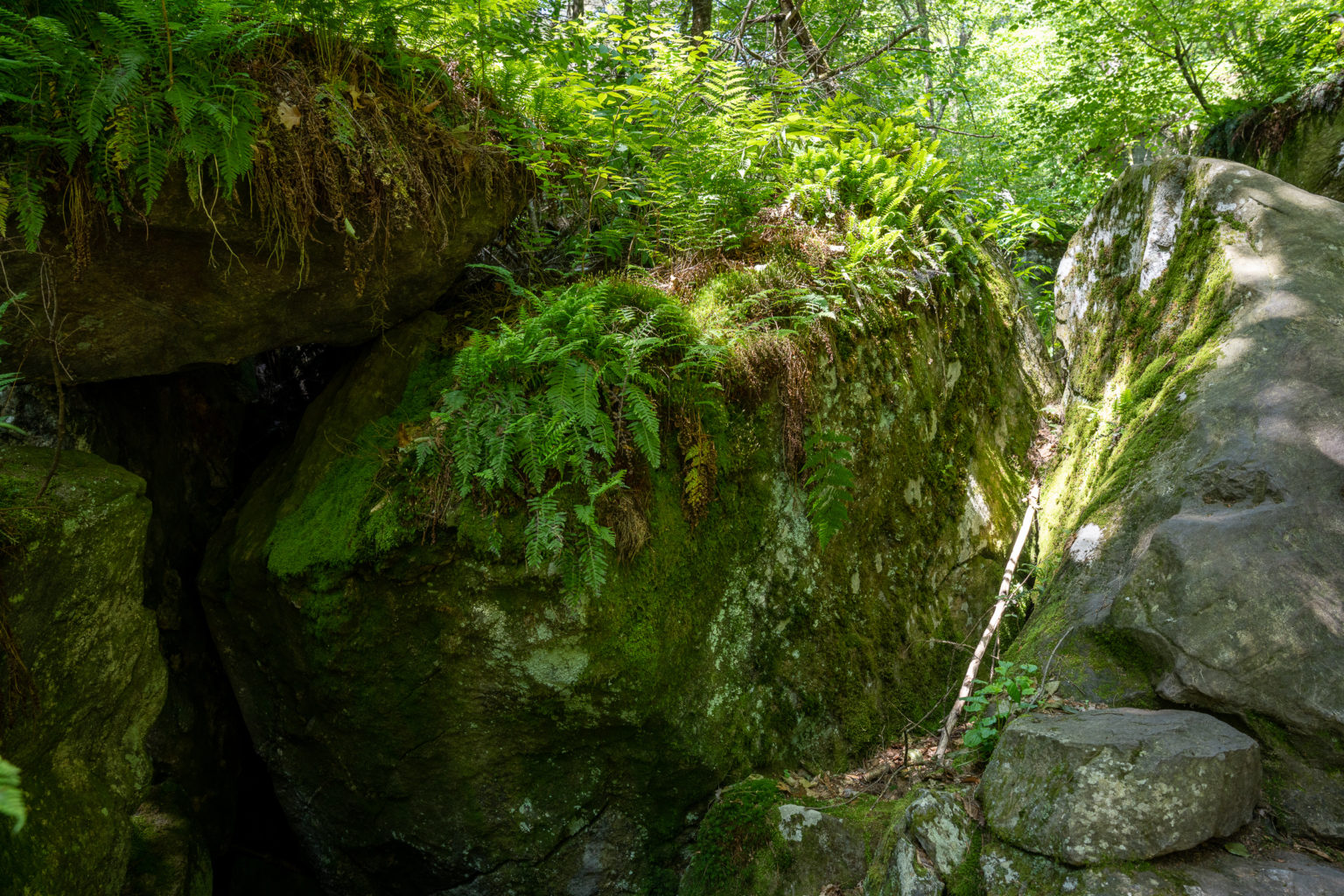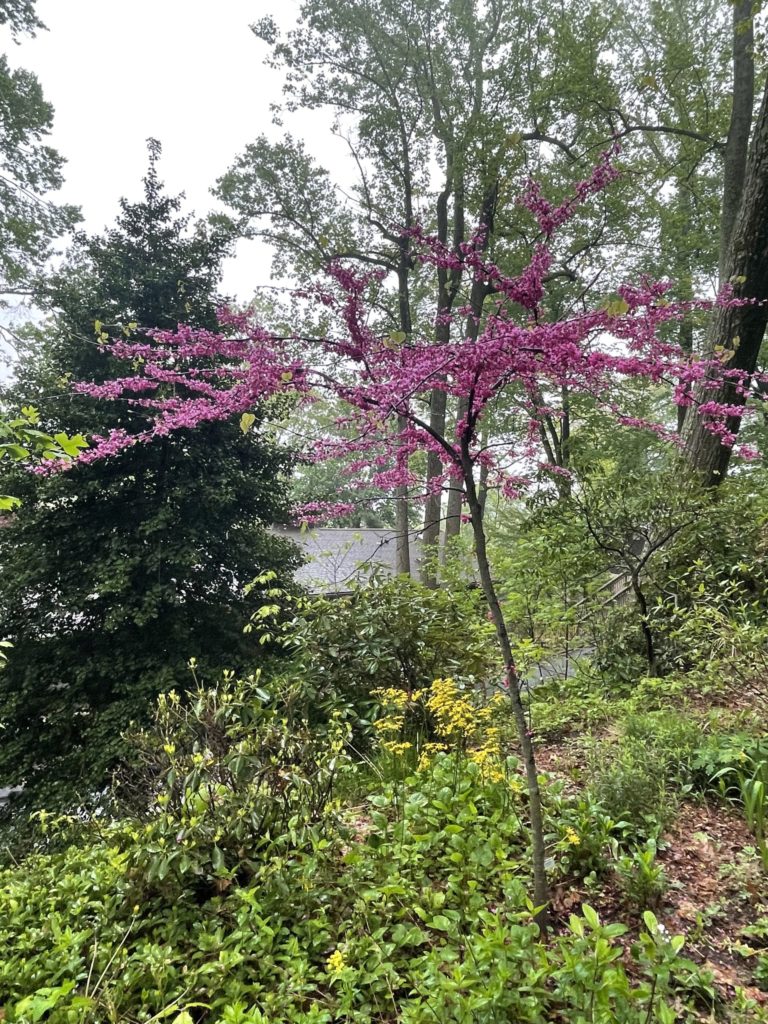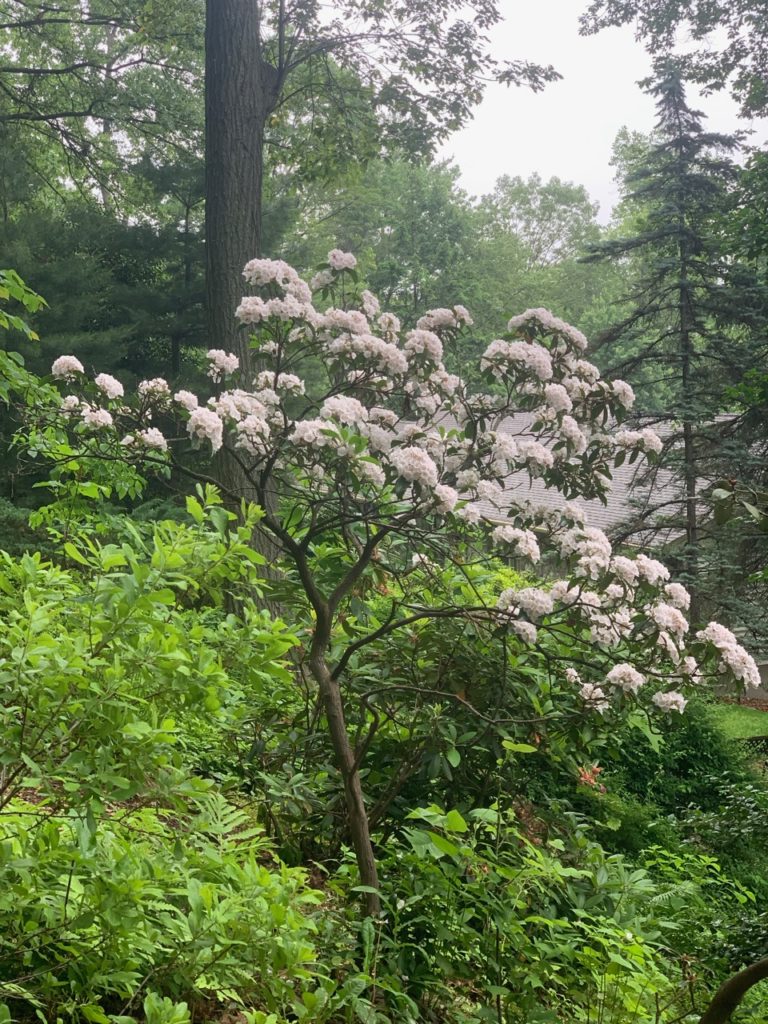Welcome to our native plant garden. Since 2017, I have been working on turning our property into a community of plants native to New Jersey and the Northeastern United States. These plants are indigenous to this territory and provide food for the beneficial insects and animals that live in this area. This page is a work in progress. I will be updating it over time, so you may want to come back. You are welcome to reach out to me here. If you want to know more about native plants, a good place to start is the Native Plant Society of New Jersey where, at present, I am the vice president for membership and chair of legislation and advocacy.
I have been an historian of architecture, researcher of network culture, professor of architecture at universities near and far, artist, and now, working on one of my most satisfying roles yet, a gardener and creator of landscapes. My intent is to create a domestic landscape that evokes the magic of the forest while benefiting our environment.
When we moved to this property in 2011, the landscape was in a sorry state, with bare patches of highly-compacted subsoil alternating with invasive species (some planted, some not) such as garlic mustard, english ivy, Japanese pachysandra, Vinca minor, burning bush, winter creeper, Japanese stiltgrass, and forsythia. Suffering three major storms in three years— Hurricane Irene, the Halloween nor’easter of 2011, and Hurricane Sandy—we had a lot of clean up to do first. We tried to hire a local landscaper, but their lack of knowledge meant that was just money wasted. Virtually nothing they planted survived. With extensive house renovations taking precedence, I wasn’t able to spend much time on the landscape until 2017.
By this point, I had discovered New Jersey gardener and writer Ken Druse’s The New Shade Garden: Creating a Lush Oasis in the Age of Climate Change and Rick Darke’s The American Woodland Garden: Capturing the Spirit of the Deciduous Forest at the Montclair Public Library. Having lived through the consequences of storms made much worse by climate change and suffering from the heat waves common around here now that the world has warmed so much, Ken Druse made me realize that I could change things for the better on my own property by providing more shade. Shade—plus evapotranspiration from plants—lowers air temperatures significantly, up to 6° F and lowers ground temperatures up to 25° F. Meanwhile, Rick Darke reminded me of my years growing up in the Berkshire Hills of Western Massachusetts, where I would wander through the woods by the Ice Glen, discovering trilliums, skunk cabbage, ferns, mosses and other plant inhabitants of one of the last patches of old growth forest in the Northeast.

This stood in stark contrast to not only my property, but to the forest in nearby Mills Reservation, where an exploding deer population has consumed virtually all native understory plant species (please don’t tell me this is because we are living in their land, on the contrary, we have eliminated predators such as coyotes, wolves, and human hunters—don’t forget the Lenape people hunted—there is 20X the deer population than what the landscape historically supported).
After reading Druse and Darke’s books, I started thinking about what might be possible with this landscape. Notwithstanding that this is called “the Garden State,” it struck me that landscaping practices in New Jersey embrace the banal with gusto. Many home gardens in the state seem to be, as gardener Pat Sutton says, “neat as a pin, ugly as sin.”
The typical strategy that homeowners embrace is to hire a landscaper (hereafter dubbed a landscraper since that is more accurate) whose main project is weed suppression and “cleanups”with gas-powered leaf blowers (ban these abominations to the senses, NOW). This, in fact, does nothing but annoy the neighbors, pollute the air, damage the property, and empty the pockets of the homeowner. It’s a racket and it flies in the face of science. The top layer of soil in an area with lots of trees, like this one, is called the “Oi Horizon” and is literally composed of undecomposed plant matter such as leaves and twigs. When you use industrial machinery to blow this away, you have gotten rid of your top layer of soil. The next layer is the “O Horizon,” composed of matter plant matter that is somewhat decomposed. Obviously the O Horizon will no longer form once the O Horizon has been blow away for a while. Below that is the “Oa Horizon,” which is made of fully decomposed organic matter and below that is subsoil. Many people in town tell me that the soil here is terrible. Not true! They just don’t see the soil, they see the red subsoil that lies below it. Often, as on this property, the subsoil has been compacted by the use of heavy machinery during construction, then subject to further damage by misguided ideas about landscaping with a bulldozer. Once, out of some misguided notion of “Stepford Wives” conformity (it’s 2022, get over wanting to live in 1955, ok?), property owners have the landscrapers get rid of all the leaves, they find that invasive plants (see that list above) colonize the increasingly barren landscape and put down mulch—too often dyed a hideous color to conceal its industrial source—to stop the weeds, thus further stealing money from their kids’ college funds. If that doesn’t work, there’s always a DIY application of Round-Up (which causes cancer, Crohn’s disease, and other awful things), or a call to the landscrapers to cut down the weeds and blow them away again using their gas-powered leaf blowers. The cycle continues, year in, year out, the property gets uglier and the only people happy are the ones laughing all the way to the bank. Even when homeowners make an effort to put something into their landscape, all too often, the result is importing exotic plants: Japanese maples, Kousa dogwoods, Japanese pachysandra and Vinca Minor are all pretty plants, but they don’t belong here. Let them grow in their native environment, not in a place where they escape to harm our woodlands. I am not going to cut down the mature trees Kousa Dogwoods or Japanese maples on my property, but I am certainly not adding any more and I am in well into a multi-year plan of eliminating the Vinca and pachysandra!
After reading Druse and Darke’s books, I found Thomas Rainer and Claudia West’s Planting in a Post-Wild World: Designing Plant Communities for Resilient Landscapes and Larry Weaner’s Garden Revolution: How our Landscapes can be a Source of Environmental Change. From Rainer and West, I learned about the idea of “green mulch.” Garden Centers and the mulch racket have sold us the idea of “plop-a-plant,” sticking a lone plant in a sea of expensive mulch (remember, you could just let the leaves from your trees do this). The result is that the plant suffers by itself and struggles to thrive. By closely planting a plant community made up of species that work together, you can create a layer of density that looks much better, create a canopy that retains humidity and lowers temperatures at the soil level, and choke out weeds. Rainer and West suggest using communities composed of native and non-native species, much as Piet Oudolf has done in places like the Lurie Garden in Chicago or James Golden has done at his fascinating Hunterdon garden Federal Twist. Although these are spectacular places and may yet be a model for future landscapes, creating plant communities from species that have never been juxtaposed requires vast knowledge of botany and horticulture that I certainly don’t have and has a great likelihood of causing disaster. Luckily, we already have plant communities native to this area that we can easily research and that’s exactly what I have done.
Any architect of intelligence will tell you that limitations are the very source of invention. By limiting my palette to native plants—and almost always straight species not cultivars—I been able to eliminate the gaudy look of weird variegated leaves, misshapen double flowers, and strangely discolored leaves so common to the suburban garden.

By the road, the property takes on the look of a woodland edge. Although previous owners apparently removed young trees with wanton abandon, I have let native trees reproduce themselves while also planting others absent from the present canopy. At the north edge, a stand of young tulip poplars that self-seeded is providing a screen for the house and will soon provide a layer of shade. Oaks have also begun to appear and, although they are slower growing, these will be the giants of the future forest, assuming that future owners (or storms) don’t do something horrible to them.

As the canopy takes care of itself, I have largely planted only understory trees such as Eastern Redbud (Cercis canadensis), Flowering Dogwood (Cornus florida), and Sassafras (Sassafras albidum). Below them, is a layer of bushes, among them native Rhododendrons (Rhododendron maximum), Mountain Laurel (Kalmia latifolia), Possumhaw Vibernum (Vibernum nudum), Winterberry Holly (Ilex verticillata), Witch Hazel (Hamamelis virginiana), Serviceberry (Amalanchier canadensis), Chokeberry (Aronia melanocarpa), Northern Bayberry (Morella pensylvanica), Pussywillow (Salix discolor), American Elderberry (Sambucus canadensis) and Spicebush (Lindera benzoin). In turn, below those is a tapestry of native perennials, among them Sharp-lobed Hepatica (Anemone acutiloba), Canada Mayflower (Anemone canadensis), Blue Cohosh (Caulophyllum thalictroides), Marginal Wood Fern (Dryopteris marginalis), Wild Geranium (Geranium maculatum), Alumroot (Heuchera americana), Ostrich Fern (Matteuccia struthiopteris), Virginia Bluebell (Mertensia virginica), Sensitive Fern (Onoclea sensibilis), Royal Fern (Osmunda regalis), Allegheny Spurge (Pachysandra procumbens), Jacob’s Ladder (Polemonium reptans), Christmas Fern (Polystichum acrostichoides), Bracken Fern (Pteridium aquilinum), Wood Poppy (Stylophorum diphyllum), and Foamflower (Tiarella cordifolia). All four of these layers—the forest canopy, the understory, bushes, and herbaceous perennials together with annuals provide visual interest throughout the year as well as providing incalculable functional benefits to the ecosystem. Already after just a few years, I’ve noticed that not only does leaving the leaves in place lead to richer soil, the plants themselves carve up the heavy subsoil below, making it easier for me to add to, or edit, the selection as I wish. Nor am I kidding myself; I sent soil from that area to the Rutgers Soil Testing Laboratory and it has very high amounts of organic matter and optimum or above optimum levels of macronutrients. Moreover, the soil is acidic, which is what forest plants expect.
Every ambitious garden has a season in which it looks best. That is simply a fact of horticulture. Seasons matter and trying to make a garden that looks great year-round is virtually impossible without replanting. On my property, I have areas that are at their best at different times. The woodland edge looks at its best in the late spring. The summer is a bit of a sorry state, but immediately south of the driveway is a little patch of flowers and grasses meant to get us through the summer. Take a look at those based on what time of year it is.
Last revised: 29 April 2023